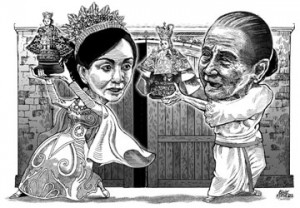
People have grown accustomed to seeing her do this every January.
The grace of her movements, and the smile on her lips, come not from years of training, but from an inner harmony that flows from a loving relationship between self and Creator.
To dance is to pray, she says. It’s been that way since she was a child.
At 87 years old, Estelita Diola has had her last dance.
An accidental fall at home in her modest house in barangay Mabolo last December added stress to a tiny hip fracture that left her flat on her back.
She’s out of the hospital now, discharged with take-home medicine and a wheelchair. She can’t rest, though.
According to her grand niece Carol, who has become her caregiver, Nang Titang insists on greeting the Señor Sto. Niño , the way they do every vesperas, in Pier 1 of Cebu City, dancing the sinulog with her troupe of Mabolo neighborhood kids and a distinctive drum beat as His “galleon” arrives, and later in various chapels and residences, including Casa Gorordo, where her annual prayer dance in the garden continues a house tradition for over a generation.
Nang Titang pleads for this chance to honor the Sto. Niño, with tears in her eyes, even if she can’t walk, has cataracts in one eye and a body diminished by age and diabetes.
“Kung na’y whheelchair, ako jud siyang dal-on sa Sinulog kay ganahan man gyud siya muadto. Mangita jud ko ug paagi para madala lang na ko siya,” said Carol.
(If we have a wheelchair, I’ll bring her to the Sinulog because she so wants to attend. I’ll find a way just to bring her.)
When Carol mentions the Sinulog, she doesn’t mean the frenzied parade of free-style dance contingents, floats and merrymaking of a festival that put Cebu on the tourist map.
She refers to the spiritual center of Cebu’s oldest fiesta and the cradle of the country’s identity as a Christian nation.
The Sto. Niño de Cebu, a military-garbed image of Jesus as a small boy, was a gift given by explorer Ferdinand Magellan to Rajah Humabon in 1521 as part of Spain’s conquest of the island. The devotion that grew from that gift, a meld of pagan cult practices and Catholic teaching, personal miracles and public veneration, is a unique root of Cebuano identity.
Nang Titang is too frail to be placed in the crush of people, who will join today’s religious processions by sea and land, which draw peak crowds of the entire nine-day novena of the Fiesta Señor.
Cebu’s oldest sinulog dancer, hailed as the “heritage keeper” of the original sinulog beat and steps of the “sin’ug” as taught to her at age 7 by her father, may not be able to stand up and dance but her legacy will not be forgotten.
Her faithful memory of the drum beat of the sinulog is an underlying foundation of the grand Sinulog Parade that gives Cebu pride of place today.
When the annual Sin’ug sa Casa Gorordo is held in the museum’s garden on Monday, Nang Titang will no longer be vigorously beating her goatskin drum, or swaying every so gracefully on the grass.
Someone else, a younger kinsman, will have to lead the homage, and stand before the table altar to recite the traditional prayers in Cebuano and Latin.
Elsewhere, another woman is waiting for her last dance in the Sinulog. The circumstances are vastly different, as she contemplates leaving her self-imposed detention in the Provincial Capitol to demonstrate her devotion to the Sto. Niño before a crowd of spectators in the grandstand.
Only the Niño knows who of the two presents a gift of dance and prayer that is a full feast of the heart.